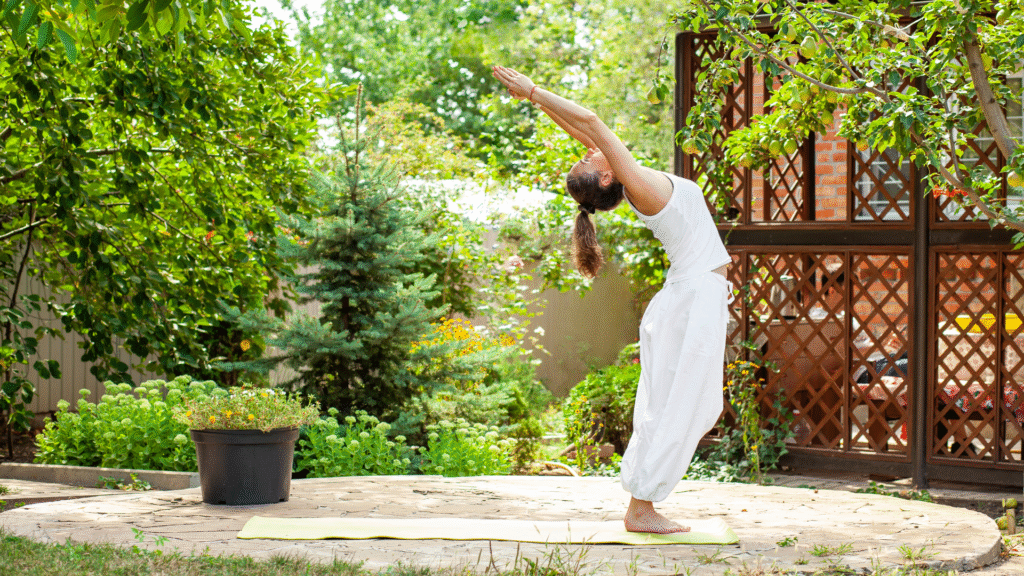Key Concepts In This Post
Flow State: a mental zone of deep focus where skill meets challenge, often described as being “in the zone.” Yoga supports flow by combining mindful breathing, movement, and presence.
“Yoga is the journey of the self, through the self, to the self.” — The Bhagavad Gita
Yoga isn’t just a physical practice—it’s a doorway into something deeper.
When I began my series of flow state experiments, I wanted to test what it really takes to enter this state of deep focus, joy, and immersion. For my first experiment, I chose yoga.
Why yoga? Because yoga yields many benefits, including increased concentration, focus, and mind-body connection. From a flow perspective, it offers the perfect balance between challenge and skill, movement and stillness, energy and peace. Psychologist Mihaly Csikszentmihalyi, who coined the term “flow,” noted that activities requiring full concentration and feedback—like yoga—are natural gateways to the flow state.
A Quick Reminder: What Is Flow?
In my last post, I defined flow as a highly focused, immersive mental state where self-consciousness fades, distractions quiet, and you become completely absorbed in the task at hand. It’s often described as the sweet spot where skill and challenge meet.
Flow isn’t just about productivity—it’s about joyful play, performance, and peace. When you know how to enter it, life feels less like an uphill climb and more like an effortless rhythm. By learning to regulate and direct your energy through flow, you can make everyday living easier, more creative, and more meaningful.
Why I Chose Yoga as My Flow State Experiment
I’ve always enjoyed yoga, but I’ve never practiced it consistently with the goal of flow in mind. A few things made it the right choice for my first experiment:
- Natural motivation: I already enjoy yoga and want to deepen my abilities.
- Solid foundation: I have prior knowledge from my Isha Yoga training, giving me a base to build from.
- Optimal challenge: Yoga challenges me physically, mentally, and spiritually without overwhelming me.
At its core, yoga means “union”—a union of body, breath, and awareness. That makes it a logical and powerful place to develop flow.
How I Used Yoga Practice to Trigger Flow
For this experiment, I chose Surya Kriya, a classical hatha yoga practice designed to energize and balance the body and mind. I structured my practice around three classic flow triggers:
- Clear goals: Complete the Surya Kriya sequence each morning, focusing on alignment, breath, and presence.
- Immediate feedback: Notice physical sensations, posture adjustments, breath quality, and thought flow (i.e. was my mind wandering away from the task-at-hand?).
- Challenge-skill balance: Maintain a sequence that was difficult enough to demand attention, but familiar enough to build on.
My working yoga-flow hypothesis was:
If I approach Surya Kriya with intentional focus on breath, presence, and seamless movement, then I will be more likely to enter a flow state—experiencing immersion, reduced mental chatter, and a sense of effort turning into ease—both during the practice and in my daily life.
Days 1–3: Laying the Foundation
- Focus: Re-familiarize myself with the Surya Kriya sequence I had learned years ago but had not recently practiced.
- Engagement: Moderate, around a 3 out of 5. My mind wandered, especially during the 61-point meditation that followed the yoga sequence, where I skipped focus points and ran out of mental steam.
- Adjustments: Added music on Day 2 to support rhythm and mood.
- Benefits: By Day 3, there were definite physical benefits. I noticed reduced aches lingering from cancer treatments and improved mobility.
Days 4–6: Building Immersion
- Focus: Excellent technical execution of three key poses within the broader sequence and cleaner transitions. I also focused on smoother breathwork—a proven way yoga improves concentration and the mind-body connection.
- Progress: Less mental energy was spent recalling the next move; more went into embodying the present one.
- Benefits: I felt comfortable with the duration of the full practice, from warm-ups to breathwork.
- Meditation: Managed one full cycle of the 61-point meditation at a higher quality, though I still missed a few focus points.
Days 7–9: Expanding Into Flow
By the final stage, my practice deepened significantly.
- Focus: Integrated breathing more fluidly into each pose, using rhythm as an anchor.
- Favorite Pose: Downward Dog, which used to hurt my wrists, became a gateway to spinal mobility and freedom. the alignment I was achieving in my body also helped the tightness that had lingered in my hips.
- Progress: Transitions felt natural, distractions were fewer, and thoughts quieted more quickly.
- Meditation: Completed two full cycles of the 61-point meditation.
While not yet perfect, my practice continued to improve, with the most notable shift being ease of movement. Effort began to transform into something smoother, calmer, almost playful. And even though I didn’t reach a flow state, I experienced moments in which I was in deeper touch with my body and mind. Over the nine days, I moved closer to a threshold of flow.
As my mind settled into my daily practice, I also became more keenly aware of my tendency to crave the desired outcome (i.e. flow state) over valuing the process. This encouraged me to gently bring my mind back to the present and consciously live each step of the sequence.
Why Yoga Is a Perfect Vehicle for Flow
This experiment reinforced what many yogis and psychologists alike have observed:
Yoga creates the conditions for flow because it combines physical challenge, focused breath, and mindful awareness into one seamless experience.
And the results weren’t confined to the mat. Each day, I noticed a little more patience, a little more focus, and a little less mental chatter outside of yoga too as I integrated the flow of my practice into other parts of my life. I observed myself pausing more often before reacting in stressful situations, an early sign that flow in yoga was reshaping my everyday presence.
Lessons Learned: Set Yourself Up for Success By Setting Your Flow Conditions
My first flow experiment taught me a few things to consider in future experiments.
- By structuring my practice with flow principles, I transformed Surya Kriya from a physical routine into a living laboratory to build toward a flow state.
- Clear goals gave my practice structure.
- Feedback through posture, breath, and thought flow kept me anchored.
- Balancing challenge and skill kept me engaged without overwhelm. An observation here is that a certain level of skill is required to keep the cognitive load at an optimal level so you can enjoy the experience.
- Thinking about flow progression through a ladder of Foundation, Immersion, Expansion, and Integration helped me steer myself mentally in my practice toward my goal. This is a framework I’ll explore further in my next experiment.
- Setting the right external environment is necessary to increase my focus and concentration. For me, this meant no distractions (i.e. no phone, pet, and people). I aimed to do my yoga early in the morning before others woke up to benefit from this tranquil time.
Next Steps on My Flow Journey
Yoga has proven to be a powerful vehicle for flow, and I’ll continue refining my practice with this lens. But my broader quest is to test flow across multiple areas of life. Each experiment is a chance to learn how to make living not just easier, but more joyful and resilient.
If you’re curious to try your own version, start small: choose a familiar yoga sequence, set a clear intention, and pay attention to your breath. See how the practice shifts.
Because the truth is, flow isn’t reserved for athletes, artists, or mystics—it’s available to anyone willing to step onto the mat, focus, and breathe.
FAQ on Yoga and Flow State
Can yoga really help you enter the flow state?
Yes. Yoga combines physical challenge, mindful breathing, and focused awareness—all proven triggers for the flow state. By practicing regularly, you create the right conditions for immersion and ease.
What is Surya Kriya, and how is it different from Surya Namaskar?
Surya Kriya is a classical hatha yoga practice taught through the Isha Yoga tradition. Unlike the more commonly known Surya Namaskar (Sun Salutation), Surya Kriya is a slower, meditative sequence designed to balance energy and prepare the mind for focus.
How long should I practice yoga daily to reach flow?
Even 20–30 minutes can be effective if practiced with full attention on breath, posture, and presence. Flow is less about duration and more about focus, feedback, and the balance between challenge and skill.
Can beginners experience flow through yoga?
Yes. Flow is possible at any skill level, as long as the challenge matches your current ability. Beginners can start with simple sequences and focus on breath and presence to create flow conditions.
Does yoga-induced flow carry over into daily life?
Absolutely. Practicing yoga with intention often leads to greater patience, sharper focus, and less mental chatter outside the mat, supporting resilience and well-being in everyday life.

